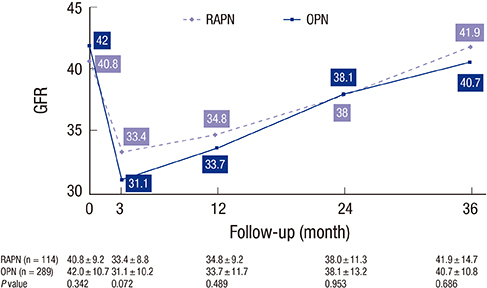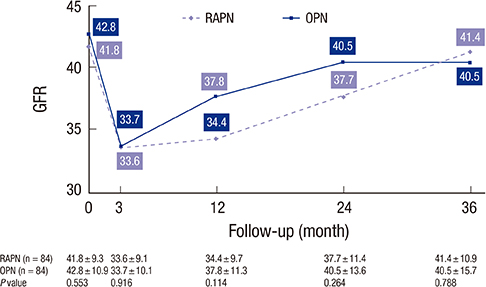J Korean Med Sci.
2016 May;31(5):743-749. 10.3346/jkms.2016.31.5.743.
Comparison of Renal Function between Robot-Assisted and Open Partial Nephrectomy as Determined by Tc 99m-DTPA Renal Scintigraphy
- Affiliations
-
- 1Department of Urology, University of Ulsan College of Medicine, Asan Medical Center, Seoul, Korea. cskim@amc.seoul.kr
- 2Department of Urology, University of Ulsan College of Medicine, Ulsan University Hospital, Ulsan, Korea.
- KMID: 2373672
- DOI: http://doi.org/10.3346/jkms.2016.31.5.743
Abstract
- We compared postoperative renal function impairment between patients undergoing robot-assisted partial nephrectomy (RAPN) and those undergoing open partial nephrectomy (OPN) by using Tc-99m diethylenetriaminepentaacetic acid (DTPA) renal scintigraphy. Patients who underwent partial nephrectomy by a single surgeon between 2007 and 2013 were eligible and were matched by propensity score, based on age, tumor size, exophytic properties of tumor, and location relative to the polar lines. Of the 403 patients who underwent partial nephrectomy, 114 (28%) underwent RAPN and 289 (72%) underwent OPN. Mean follow-up duration was 35.2 months. Following propensity matching, there were no significant differences between the two groups in tumor exophytic properties (P = 0.818) or nephrometry score (P = 0.527). Renal ischemic time (24.4 minutes vs. 17.8 minutes, P < 0.001) was significantly longer in the RAPN group than in the OPN group, while the other characteristics were similar. Multivariate analysis showed that greater preoperative renal unit function (P = 0.011) and nephrometry score (P = 0.041) were independently correlated with a reduction in glomerular filtration rate. The operative method did not correlate with renal function impairment (P = 0.704). Postoperative renal function impairment was similar between patients who underwent OPN and those who underwent RAPN, despite RAPN having a longer ischemic time.
Keyword
MeSH Terms
Figure
Cited by 1 articles
-
Open Partial Nephrectomy vs. Robot-assisted Partial Nephrectomy for a Renal Tumor Larger than 4 cm: a Propensity Score Matching Analysis
Sangchul Lee, Hoyoung Ryu, Jeong Woo Lee
J Korean Med Sci. 2021;36(20):e135. doi: 10.3346/jkms.2021.36.e135.
Reference
-
1. Van Poppel H, Da Pozzo L, Albrecht W, Matveev V, Bono A, Borkowski A, Colombel M, Klotz L, Skinner E, Keane T, et al. A prospective, randomised EORTC intergroup phase 3 study comparing the oncologic outcome of elective nephron-sparing surgery and radical nephrectomy for low-stage renal cell carcinoma. Eur Urol. 2011; 59:543–552.2. Huang WC, Levey AS, Serio AM, Snyder M, Vickers AJ, Raj GV, Scardino PT, Russo P. Chronic kidney disease after nephrectomy in patients with renal cortical tumours: a retrospective cohort study. Lancet Oncol. 2006; 7:735–740.3. Porpiglia F, Volpe A, Billia M, Scarpa RM. Laparoscopic versus open partial nephrectomy: analysis of the current literature. Eur Urol. 2008; 53:732–742.4. Ficarra V, Bhayani S, Porter J, Buffi N, Lee R, Cestari A, Mottrie A. Predictors of warm ischemia time and perioperative complications in a multicenter, international series of robot-assisted partial nephrectomy. Eur Urol. 2012; 61:395–402.5. Mottrie A, De Naeyer G, Schatteman P, Carpentier P, Sangalli M, Ficarra V. Impact of the learning curve on perioperative outcomes in patients who underwent robotic partial nephrectomy for parenchymal renal tumours. Eur Urol. 2010; 58:127–132.6. Aboumarzouk OM, Stein RJ, Eyraud R, Haber GP, Chlosta PL, Somani BK, Kaouk JH. Robotic versus laparoscopic partial nephrectomy: a systematic review and meta-analysis. Eur Urol. 2012; 62:1023–1033.7. Froghi S, Ahmed K, Khan MS, Dasgupta P, Challacombe B. Evaluation of robotic and laparoscopic partial nephrectomy for small renal tumours (T1a). BJU Int. 2013; 112:E322–33.8. Benway BM, Bhayani SB, Rogers CG, Dulabon LM, Patel MN, Lipkin M, Wang AJ, Stifelman MD. Robot assisted partial nephrectomy versus laparoscopic partial nephrectomy for renal tumors: a multi-institutional analysis of perioperative outcomes. J Urol. 2009; 182:866–872.9. Sprenkle PC, Power N, Ghoneim T, Touijer KA, Dalbagni G, Russo P, Coleman JA. Comparison of open and minimally invasive partial nephrectomy for renal tumors 4-7 centimeters. Eur Urol. 2012; 61:593–599.10. Boylu U, Basatac C, Yildirim U, Onol FF, Gumus E. Comparison of surgical, functional, and oncological outcomes of open and robot-assisted partial nephrectomy. J Minim Access Surg. 2015; 11:72–77.11. Amano H, Kondo T, Hashimoto Y, Kobayashi H, Iizuka J, Shimada K, Nakazawa H, Ito F, Tanabe K. Contralateral metachronous tumor occurrence is more frequently associated with distant metastases or postoperative intrarenal recurrence in renal cell carcinoma patients. Int J Urol. 2010; 17:615–622.12. Kutikov A, Uzzo RG. The R.E.N.A.L. nephrometry score: a comprehensive standardized system for quantitating renal tumor size, location and depth. J Urol. 2009; 182:844–853.13. Clavien PA, Barkun J, de Oliveira ML, Vauthey JN, Dindo D, Schulick RD, de Santibañes E, Pekolj J, Slankamenac K, Bassi C, et al. The Clavien-Dindo classification of surgical complications: five-year experience. Ann Surg. 2009; 250:187–196.14. Ahlering TE, Skarecky D, Lee D, Clayman RV. Successful transfer of open surgical skills to a laparoscopic environment using a robotic interface: initial experience with laparoscopic radical prostatectomy. J Urol. 2003; 170:1738–1741.15. Lee S, Oh J, Hong SK, Lee SE, Byun SS. Open versus robot-assisted partial nephrectomy: effect on clinical outcome. J Endourol. 2011; 25:1181–1185.16. Simhan J, Smaldone MC, Tsai KJ, Li T, Reyes JM, Canter D, Kutikov A, Chen DY, Greenberg RE, Uzzo RG, et al. Perioperative outcomes of robotic and open partial nephrectomy for moderately and highly complex renal lesions. J Urol. 2012; 187:2000–2004.17. Oh JJ, Byun S, Hong SK, Jeong CW, Lee SE. Comparison of robotic and open partial nephrectomy: Single-surgeon matched cohort study. Can Urol Assoc J. 2014; 8:E471–5.18. Minervini A, Vittori G, Antonelli A, Celia A, Crivellaro S, Dente D, Di Santo V, Frea B, Gacci M, Gritti A, et al. Open versus robotic-assisted partial nephrectomy: a multicenter comparison study of perioperative results and complications. World J Urol. 2014; 32:287–293.19. Lee CS, Cha RH, Lim YH, Kim H, Song KH, Gu N, Yu KS, Lim CS, Han JS, Kim S, et al. Ethnic coefficients for glomerular filtration rate estimation by the Modification of Diet in Renal Disease study equations in the Korean population. J Korean Med Sci. 2010; 25:1616–1625.20. Stevens LA, Coresh J, Greene T, Levey AS. Assessing kidney function--measured and estimated glomerular filtration rate. N Engl J Med. 2006; 354:2473–2483.21. Fergany AF, Saad IR, Woo L, Novick AC. Open partial nephrectomy for tumor in a solitary kidney: experience with 400 cases. J Urol. 2006; 175:1630–1633.22. Gill IS, Colombo JR Jr, Moinzadeh A, Finelli A, Ukimura O, Tucker K, Kaouk J, Desai M. Laparoscopic partial nephrectomy in solitary kidney. J Urol. 2006; 175:454–458.23. Hillyer SP, Bhayani SB, Allaf ME, Rogers CG, Stifelman MD, Tanagho Y, Mullins JK, Chiu Y, Kaczmarek BF, Kaouk JH. Robotic partial nephrectomy for solitary kidney: a multi-institutional analysis. Urology. 2013; 81:93–97.24. Choi KH, Yoon YE, Kim KH, Han WK. Contralateral kidney volume change as a consequence of ipsilateral parenchymal atrophy promotes overall renal function recovery after partial nephrectomy. Int Urol Nephrol. 2015; 47:25–32.25. Zargar H, Akca O, Autorino R, Brandao LF, Laydner H, Krishnan J, Samarasekera D, Stein RJ, Kaouk JH. Ipsilateral renal function preservation after robot-assisted partial nephrectomy (RAPN): an objective analysis using mercapto-acetyltriglycine (MAG3) renal scan data and volumetric assessment. BJU Int. 2015; 115:787–795.26. Zargar H, Porpiglia F, Porter J, Quarto G, Perdona S, Bertolo R, Autorino R, Kaouk JH. Achievement of trifecta in minimally invasive partial nephrectomy correlates with functional preservation of operated kidney: a multi-institutional assessment using MAG3 renal scan. World J Urol. Forthcoming. 2015.27. Funahashi Y, Yoshino Y, Sassa N, Matsukawa Y, Takai S, Gotoh M. Comparison of warm and cold ischemia on renal function after partial nephrectomy. Urology. 2014; 84:1408–1412.28. Funahashi Y, Hattori R, Yamamoto T, Sassa N, Fujita T, Gotoh M. Effect of warm ischemia on renal function during partial nephrectomy: assessment with new 99mTc-mercaptoacetyltriglycine scintigraphy parameter. Urology. 2012; 79:160–164.29. Ginzburg S, Uzzo R, Walton J, Miller C, Kurz D, Li T, Handorf E, Gor R, Corcoran A, Viterbo R, et al. Residual parenchymal volume, not warm ischemia time, predicts ultimate renal functional outcomes in patients undergoing partial nephrectomy. Urology. 2015; 86:300–305.30. Kwon T, Jeong IG, Ryu J, Lee C, Lee C, You D, Kim CS. Renal function is associated with nephrometry score after partial nephrectomy: a study using diethylene triamine penta-acetic acid (DTPA) renal scanning. Ann Surg Oncol. 2015; 22:Suppl 3. 1594–1600.31. Khalifeh A, Autorino R, Eyraud R, Samarasekera D, Laydner H, Panumatrassamee K, Stein RJ, Kaouk JH. Three-year oncologic and renal functional outcomes after robot-assisted partial nephrectomy. Eur Urol. 2013; 64:744–750.32. Koo HJ, Lee DH, Kim IY. Renal hilar control during laparoscopic partial nephrectomy: to clamp or not to clamp. J Endourol. 2010; 24:1283–1287.33. Zargar H, Akca O, Ramirez D, Brandao LF, Laydner H, Krishnan J, Stein RJ, Kaouk JH. The impact of extended warm ischemia time on late renal function after robotic partial nephrectomy. J Endourol. 2015; 29:444–448.34. Simmons MN, Lieser GC, Fergany AF, Kaouk J, Campbell SC. Association between warm ischemia time and renal parenchymal atrophy after partial nephrectomy. J Urol. 2013; 189:1638–1642.35. Volpe A, Blute ML, Ficarra V, Gill IS, Kutikov A, Porpiglia F, Rogers C, Touijer KA, Van Poppel H, Thompson RH. Renal ischemia and function after partial nephrectomy: a collaborative review of the literature. Eur Urol. 2015; 68:61–74.
- Full Text Links
- Actions
-
Cited
- CITED
-
- Close
- Share
- Similar articles
-
- Comparison of Tc-99m MAG, and Tc-99m DTPA Renal Scans in Patients with Upper Urinary Tract Obstruction
- (99m)Tc-HDP Bone Scintigraphy Finding of Metastatic Renal Cell Carcinoma Bone Lesion Changed from Hot to Cold Lesion: Comparing with (18)F-FDG PET/CT
- Paradoxical Hyperfunctioning Kidney on the Renal Scan in Patients with Ureteropelvic Junction Obstruction
- Clinical Usefulness of GFR Measurement Using Tc-99m DTPA Renal Scan in Kidney Transplantation Patients
- The Correlation between Relative Renal Uptake of (99m)Tc-DMSA Renal Scan and Glomerular Filtration Rate in Patients with Reduced Renal Function



